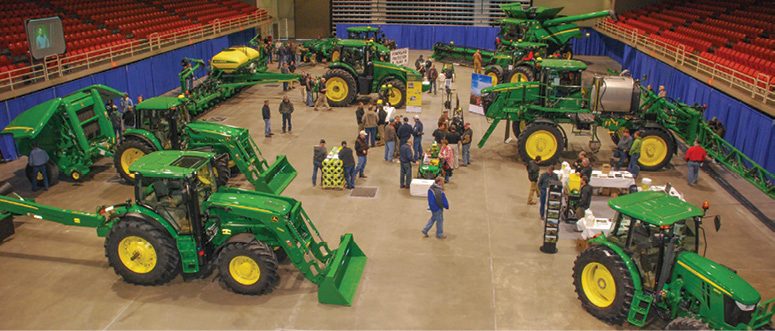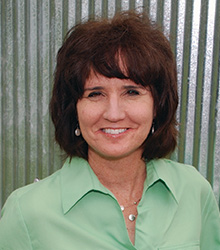Hosting an event at your store — whether a product introduction, open house or clinic — brings customers in and allows them to interact with your employees and often brings in some parts sales. Advance planning takes anywhere from weeks to months, and when it comes time for the event dealers usually have to close their shop for 1-3 days. Two dealerships — Mid-State Equipment and Hiawatha Implement — recently expanded their customer appreciation events and held them at large facilities away from the dealerships.
Mid-State Equipment is a 6-store John Deere dealership with locations in Columbus, Watertown, Jackson, Janesville, Praire Du Sac and Salem, Wis. Previously, the dealership had an Expo Week each year in February, with a different store hosting an open house and planter clinic on different days.
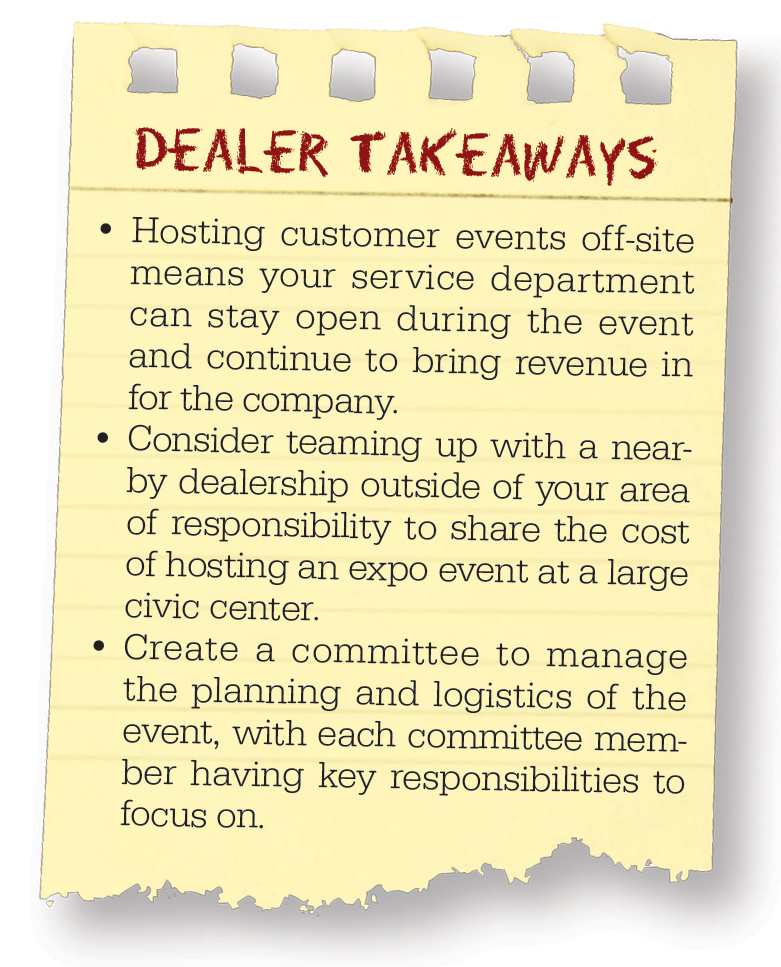
Hiawatha Implement is a John Deere dealership with 2 locations in Hiawatha, Kan., and Mound City, Mo., and typically held new product introductions in January at a local community building. Attendance at the events was low and it was time for a change.
Moving the events off site meant more space and more products on display for both dealerships. In addition, a larger location meant there was room for more attendees. Each dealership’s event that were held off-site drew about 1,000 customers each.
In addition to being able show more products to more people, the off-site expos allowed both dealerships to offer a variety of classroom clinics simultaneously.
Finding a Better Way
“It’s an exhausting week of six different events and it was just a lot for many members of our team to organize those six different days. Our shops are shut down for about 2 days, one for the event, one to clean and probably actually more than that to get back to fully operational the next day,” says Chris Frodel, co-owner of Mid-State Equipment.
Bringing all six events together into one big expo in a central location away from the stores meant Mid-State didn’t have to sacrifice as much shop and service time during the week of the event. It also meant a lot more equipment could be viewed by customers. Instead of just having a handful of products on display, Mid-State set up 15 different booths full of products for their customers to explore.
This year marks Mid-State Equipment’s 40th Anniversary. “If there’s ever a good year to try something like this, it’s probably this year — the 40th anniversary,” Frodel says.
When Mid-State wrapped up last year’s Expo Week, it didn’t take long for the leadership group to start discussing ways to improve the next event. Co-owner Bryan Hanson had read an article in The Leader, a John Deere publication, about a dealer who rented auditorium space to hold its event. “Immediately, our first thought was we can’t, it’s going to be too expensive and we won’t be able to justify it,” he says. “But to be truthful, nobody really knew what it was going to cost to rent a place like the Alliant Energy Center in Madison, Wis.”
Mid-State didn’t let that initial doubt stop them and began researching how much it would cost and put a planning committee together consisting of the director of sales Eric Stith, ag sales manager Mike Berkevich, marketing coordinator Beth Halverson, corporate rental manager Kurt Orcutt and corporate aftermarket manager Jay Goninen. “Once we started looking into it and got a true idea of what it really cost to do the events individually at each store compared to doing something like this, we saw we could justify it,” Hanson says.
The planning committee spent about 7 months preparing for the big event. In November, they presented their plan to Mid-State’s ownership group — Hanson, Frodel and their parents, founders of the company, Curt and Linda Hanson. “It gave us the opportunity to offer changes we’d like to see or offer up ideas we had, and it gave them enough time to retool and do some things differently. It gave us a chance to kind of poke holes in their plan and say, ‘Are you doing this, did you miss this?’” Frodel says.
 Mid-State Equipment formed a committee of five employees to oversee the planning and organizing of its 40th Anniversary Expo. The committee was made up of (l to r) corporate aftermarket manager Jay Goninen, ag sales manager Mike Berkevich, marketing coordinator Beth Halverson, director of sales Eric Stith and corporate rental manager Kurt Orcutt. |
While the final numbers weren’t in yet, Hanson estimates the cost of hosting one large expo vs. six smaller ones at each location was about 30% more, but with each store remaining open during the event the service technicians were able to keep working and producing revenue, he says.
6 Events vs. 1 Event
By bringing all the events together at one centralized location, Mid-State was able to offer its customers a better experience. With limited space at the stores, they’d usually only have a tractor and planter set up because the expos included a planter clinic as well, Frodel says. “Aside from a couple other pieces set up outside of the dealership, that was about it. At some of our larger stores like Columbus and Janesville we could have a planter hooked up inside as well as some Kuhn or Landoll Equipment. And then it’s not conducive either because most of it is parked outside and it’s cold. Who wants to drive or look at a piece of equipment when it’s cold?” she says.
Mid-State was also able to reach more customers by bringing the events together. The dealership sent out about 4,000 invitations for the one-day event. Hanson estimates they had approximately 1,000 people pass through the doors throughout the day.
“A lot of our customers who deal with us on a regular basis don’t even know the breadth of the products we offer, and being able to see them all in one place like that, they were able to see all the things that we carry,” Hanson says.
On the day of the expo, Mid-State had 50 staff members working the event. In addition, they had supplier representatives from John Deere, Kuhn, Landoll, J&M, Meyer, Wacker Neuson and Bobcat.
Increased Education
 Hiawatha Implement and Horizon Equipment mailed or hand delivered this flyer only to customers who purchased equipment in the last 3 years. They wanted to have a targeted group of attendees. |
Over the course of the day, Mid-State offered five different classroom sessions, each running four times throughout the day. “We did have sessions at our individual stores, but because of space constraints we were only able to have two different sessions — one in the morning and one in the afternoon covering different topics,” Hanson says.
He says each session they offered was packed. The topics included: John Deere Sprayers, John Deere Precision Technology, Planters & Drills, Bobcat and John Deere Tractors & Tier 4 Engines.
“All classes were put on by our own people, most of them by our technicians from various stores. They put a lot of time into planning their presentation. We had them do a dry run in front of three or four of our staff members 2 weeks before the expo as well so it wasn’t just going in that day and doing it, they had to do a dry run and have it critiqued and picked apart.”
Logistical Organization
Hanson and Frodel agree the biggest logistical challenge was getting all the equipment to Madison. Mid-State worked with a local trucking firm to help move the majority of the smaller equipment that could fit inside enclosed trailers. “They had the equipment color coded and then they had the trailer color coded so we knew exactly where it came from and where it had to go back to,” Frodel says. “We had little maps inside all the enclosed trailers of how stuff should be put in the trailer. It was very organized.”
Hanson says they also staged all the equipment at three major locations, which meant they were moving equipment to those locations in the weeks leading up to the expo. On the Sunday before the event, they began driving the large equipment to the Alliant Energy Center. Once it arrived it was covered in salt from the roads and the next challenge was getting it cleaned. Mid-State set up a wash bay and hired a detailing company to come in and assist with getting all the equipment cleaned up and ready to show. The Alliant Center put together a CAD drawing of how all the equipment would be placed, so once they arrived they knew exactly where each piece was going, Frodel says. The group spent the majority of Tuesday setting up and arranging the equipment and then the expo was held on Wednesday.
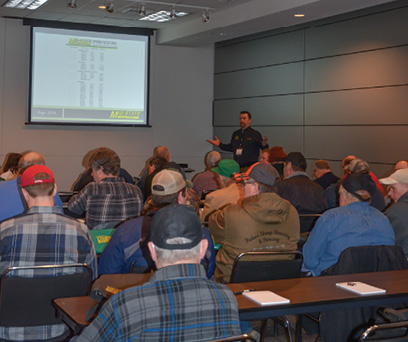 Mid-State was able to increase its classroom sessions from 2 to 5 by holding its expo at the Alliant Energy Center in Madison, Wis., rather than hosting 6 individual events at different stores over the course of a week. |
Being organized came in handy as well when it was time to clear out when the expo ended. Hanson says they were able to get the building completely cleared out in 1.5-2 hours. “We had to be highly organized because it’s a lot of moving parts and there was a lot of people moving in and out, but it was really well orchestrated and really worked well,” he says.
Dealerships Team Up
Hiawatha Implement is a John Deere dealership with locations in Hiawatha, Kan., and Mound City, Mo. Nicholas Blevins, integrated solutions manager, describes their typical equipment introduction event this way: “It would have been pancakes at a community building in Hiawatha.” He is referring to the annual small meetings they held each January, where they gave PowerPoint presentations on new equipment and technology. “Past turnout was considered unacceptable. A day was spent preparing and the events started first thing in the morning, which were difficult to get customers interested.”
They would typically follow up those meetings with clinics in the spring and fall — and had planned to do the same thing this year.
“We were planning new technology clinics on GPS tools and Apex (farm management software). I was having a lot of conversations with our new sales manager (Chad Gormley) and we started brainstorming ideas in December. We then decided to roll it all up into one big event,” says Blevins. That “big event” needed a whole new approach.
“The priority was getting selected customers in at once to see the tractors and start pressing buttons — in real time,” Blevins says. He began researching outside venues that could hold numerous pieces of large equipment and host a large crowd. The civic arena in St. Joseph, Mo., was the best choice for size, but was about 40 miles away from Hiawatha. It was also in the backyard of another John Deere dealer, Horizon Equipment.
“We sat down with their sales manager and general manager and told them about our idea. They jumped on board and it became a team effort,” says Blevins. The two dealerships are not in competing territories.
 The civic arena in St. Joseph, Mo., may have been filled with oversized machines, but the dealership teams from Hiawatha Implement and Horizon Equipment focused on sharing details with customers. |
“We thought it would be very beneficial. We were going to have our own clinics anyway and this way we’re not shutting down our shop to have the event. Our store could still function during the event,” says Jason Boyd, Horizon’s general manager. Horizon is located in Easton, Mo., about 5 miles east of St. Joseph. “We would normally have just focused on a planter or a combine. Now we could promote everything from lawn and garden to small ag to big ag.”
The teams decided on a mid-February, 2-day New Product Expo, so they needed to work fast to organize and promote it. The dealerships worked together to choose the equipment and decide which dealership would be responsible for delivery. Because of its proximity, Horizon delivered most of the large pieces, driving them to the arena. They prepared a scaled drawing, so they knew where they wanted the equipment placed. The dealerships also split up the educational sessions. Horizon has more rural lifestyle customers, so they handled the small ag and hay presentation. Hiawatha delivered the large ag training sessions, which focused on precision ag technology, equipment and implementation.
The dealerships kept promotions simple and targeted. They developed a flyer that was mailed or hand delivered to customers who had purchased equipment in the last 3 years.
Expo Covers it All
The Expo displayed equipment for all types of customers, along with new technology. New production ag equipment on display included an S series combine with John Deere’s new HydraFlex draper head, a 4000R series sprayer and 7R and 8R series tractors as well as a 1790 planter and a 2623VT vertical tillage tool.
Small ag equipment displays included compact tractors (5000 and 6000 series), subcompact utility tractors (1025R) and hay equipment (MOCO 835 mower condition and 569 round baler) as well as the new sport and utility Gator vehicles. The expo also included the 100 series to 900 series of mowers and the 1000 to 4000 series of tractors.
In addition equipment displays, the event also included a technology booth, showing the Field Connect soil management system, receivers for guidance systems, rate controllers and wireless data transfer systems.
“Each cab had the ‘command center’ on the armrest so people could get in the cab and use them. Customers were encouraged to come and work with the technology and ask questions,” Blevins says.
The dealership teams also put on an impressive schedule of clinics. “We prepared PowerPoint presentations for each clinic and had enough room for 50 people per clinic,” says Blevins.
The clinics were held in rooms separate from the show floor and were broken down into the following topics: new technology and planter clinics; Apex and JDLink/myjohndeere.com; hay and small ag equipment; and John Deere insurance.
“New products along with data management are the future focus of John Deere and Hiawatha Implement’s portfolio. Customers want more training, and with the products leading the way, we are trying to stay on top and provide information to customers as soon as we have it,” he says.
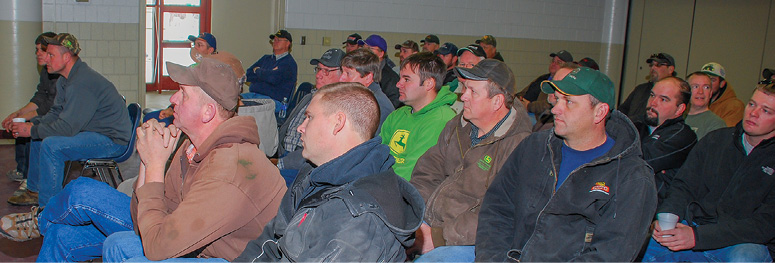 Hiawatha and Horizon’s expo featured clinics on precision ag technology and the requirement for tractors and attachments, small ag and hay equipment and insurance. Here, a full room of producers listens in on new technology topics. |
Both dealerships made sure the expo was staffed with experts — about 40 employees from both stores were on the show floor.
“Three to five parts salesmen were at parts booth and all of the ag salesman were out on the floor with their equipment. We also had 3-5 technicians per store to help people with parts and operational questions,” Blevins says. “We had a sign-in book when customers entered the show and the Hiawatha FFA chapter helped us welcome people and serve coffee.”
Lunch was served both days as well and was catered by a relative of a Hiawatha manager.
Selling Not the Goal
The dealerships planned for 300-500 attendees per day.
“No advertising was done, only invitations were sent to a targeted list,” Blevins says. “No push was made during the event to push customers to buy, especially to minimize any competition between the two dealerships. The primary goal was to educate and answer customer’s questions and show products that were available and how they could be utilized on the farm.”
Boyd says his dealership shares the same goal. “Sales would be a bonus. We just wanted people to come and see the new products up close. With our events before, we might have had 80 people come through our store. Now, we’re hoping to reach 1,000 or more.”
Blevins defines success this way: “A successful expo would be measured by attendance, along with customers being satisfied, feeling comfortable with the equipment and having a successful 2014 growing season.”
Gormley, Hiawatha’s sales manager, says they are planning to send a postcard survey following the event, to gather feedback from attendees.
“You always have to look at the numbers and how many customers showed up, but it’s better to have the right producers attend and feel like they really got something from the event.”

